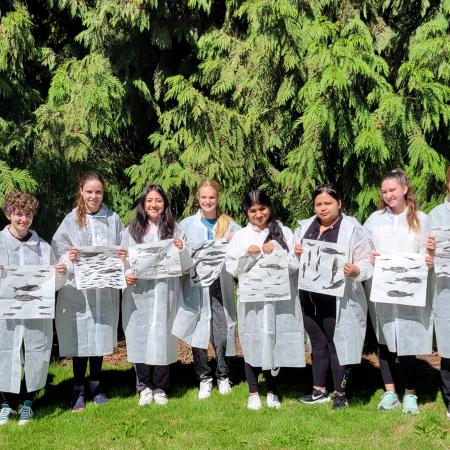These guidelines are to ensure a fair and equitable review of teaching faculty efforts, so that faculty are well-represented in the promotion and tenure process. They are based on the general guidelines and minimum criteria set forth by the College of Agriculture Sciences (August 2017). All tenure-track and instructor faculty must undergo periodic peer evaluation of teaching (defined below). Peer evaluation of teaching reviews should be positive, constructive, evaluative, and reflective experiences for the teaching faculty member, and should be conducted fairly and with a spirit of collegiality.
The goals of peer evaluation of teaching are to:
- Assist in the improvement of teaching,
- Foster faculty collaboration for the purpose of assessing teaching, and
- At times provide an assessment used in evaluation for promotion and tenure.
Peer evaluations of teaching will focus on providing input and assessment to teaching faculty from their peers, and as such, student input is not required. However, periodic peer evaluations of teaching are only one element of maintaining high quality teaching, and other evaluations (e.g., eSET scores/participant evaluations, annual performance evaluations, student interviews) may be conducted as part of an overall assessment process. When student input is specifically required for dossiers for promotion or tenure, that input comes from a separate student committee. The letter from the student committee is separate from, and should not be confounded with, the letter provided by the unit’s Peer Evaluation of Teaching Committee.
Frequency of peer evaluations of teaching
Teaching faculty may request a peer evaluation of teaching at any time, and unit heads may initiate more frequent reviews if desired; otherwise, “periodic” is defined for different types of instructional faculty by the faculty handbook as such:
- Instructor faculty should undergo evaluation of their teaching portfolio annually prior to promotion, then at least every other year until promotion to senior instructor II, with at least 2 reviews completed prior to promotion.
- Non-tenured assistant professors and tenured associate professors will undergo peer evaluation of teaching at least twice prior to submitting their dossier for promotion and tenure, with the first review conducted prior to the end of the mid-promotion review, the timing of which will be dependent on if the faculty member goes up early for promotion and tenure. The intent of these peer evaluations of teaching is to identify, well in advance of the promotion and tenure deliberations, areas of teaching that may need improvement.
Full professors and Senior Instructor II faculty members are not required to undergo periodic peer evaluation of teaching for the purposes of promotion and tenure. Peer evaluations of teaching for full professors, Sr. Instructors II, or non tenure-track faculty with teaching responsibilities can be requested at the discretion of the unit head or the faculty member.
Membership and Roles of Peer Evaluation and Advisement of Teaching Committee
The evaluation committee consists of a minimum of 2 members:
Committee chair
A member from the teaching faculty member’s home department.
The committee chair is appointed by the Unit Head at the initial appointment of the teaching faculty member. The committee chair's role is to:
- Select the outside department committee member.
- Conduct periodic classroom evaluations of teaching (see criteria below) that include all courses taught.
- Solicit additional classroom evaluations from peer faculty.
- Meet and discuss evaluations with teaching faculty member.
- Work with outside department committee member to summarize committee findings in a review letter.
- Provide review letters during promotion and tenure.
Outside member
A peer faculty member from outside the teaching faculty member’s home department.
This member may provide new perspectives on teaching and objective assessment. The outside committee member is appointed by the committee chair at the time of evaluation. It is not necessary for the external committee member to be a content expert, as their evaluation may focus on the teaching delivery and not the content. However, this is an opportunity to engage our adjunct faculty, who could evaluate content.
The outside member's role is to:
- Participate in evaluation of teaching faculty through examination of the compiled teaching dossier and peer classroom evaluations (conducting additional classroom observations is optional).
- Participate in the writing of the review letter.
- Meet and discuss evaluation with teaching faculty member.
The peer review process
“Peer evaluation of teaching” is defined as a systematic review of all teaching contributions and materials of an instructional faculty member. The committee will use the “Six Principles of University Teaching” and the Departmental Evaluation Criteria (appended below) as a guide for conducting evaluations. All teaching faculty being reviewed will compile a teaching dossier that should include relevant teaching materials, allowing the committee to more easily address the faculty member’s instructional contributions, development, and proficiency:
- A short description of their approach to teaching and the accomplishments and challenges experienced since the last review. These descriptions should develop into a narrative that will become part of the P&T dossier. Candidates should consider providing specific examples of how their teaching duties address specific evaluation criteria in their statements.
- Canvas website access or provision of course syllabi, learning outcomes, text, reading assignments, examinations and other class material, such as lecture slides.
The Peer Review of Teaching Committee
Writes a letter that summarizes their findings broadly considering the Six Principles of University Teaching and Departmental Evaluation Criteria and based on the following components:
- The faculty narrative
- Classroom evaluations of teaching by peer faculty, which include observations of representative courses taught by the faculty member, and that create a complete picture of the faculty’s development,
- Relevant teaching materials provided by the faculty member.
Periodically meets with the teaching faculty member to summarize findings, discusses issues raised during the review, if any, and provides an opportunity for the teaching faculty member to respond to committee findings.
Evaluation of first-time teaching faculty
The committee will be formed at the start of a teaching faculty member’s promotion cycle. In order to instigate engagement by the committee at crucial times in a teaching faculty member’s development, the following evaluation schedule should be used:
- The committee should meet with first-time teaching faculty before their teaching requirements begin to prepare for the individual for the initial teaching experience, and to detail what the performance expectations are.
- The committee may hold an optional meeting soon after the instructor has taught their first course. This meeting would act as a time to reflect on the process and to review initial student feedback in a constructive manner.
- The first formal review will be conducted before the mid-promotion cycle point to evaluate the progression of the faculty member and to provide additional support and direction, as needed.
- A second formal review should be conducted prior to promotion consideration.
Evaluation of faculty past their first promotion and going up for promotion to full professor or senior instructor
A new committee will be formed for faculty recently promoted to the rank of Associate Professor, and the following evaluation schedule should be used:
- The first formal review will be conducted before the mid-promotion cycle point to evaluate the progression of the faculty member and to provide additional support and direction, as needed.
- A second formal review should be conducted prior to promotion consideration.
A new committee will be formed for faculty recently promoted to the rank of Sr. Instructor I, and the following evaluation schedule should be used:
- Formal reviews should be conducted every other year prior to promotion consideration.
The committee members and the teaching faculty should sign evaluation documents, and the teaching faculty member may submit a response to the review to the unit head. This may include what they learned, what they will implement, and if they have already made changes.
Contribution to the P&T Dossier
A letter from the peer teaching review committee that summarizes all peer teaching reviews over the evaluation timeline will be included in the dossier.
Departmental Evaluation Criteria
Adapted from The University of Missouri. 1992. Teaching Evaluation. And Seldin, P. 1985. Changing Practices in Faculty Evaluation. Jossey-Bass Publishers, San Francisco.
Content
- Is content up-to-date? Are there areas that could be made more up-to-date?
- Does the content appropriately reinforce key concepts of the overall curriculum? Are there ways to provide opportunities to practice or apply them in new and different ways?
- How does content supplement the department curriculum in non-redundant, complementary ways?
- How appropriate is the breadth and depth of coverage of the content?
Outcomes
- Are the course learning outcomes sufficiently aligned with course content allowing for assessment tools to accurately gauge outcome successes?
- How does the instruction incorporate the appropriate concepts, information, and skills that will allow outcomes to be achieved?
- Are there opportunities for students to display creative thinking, initiative, self-directed research, and/or scholarship skills commensurate with their level of education?
- Are analytical skills taught and tested?
- How does the educator encourage students to think critically?
Assessment
- Are assessment tools clearly written and fairly graded?
- How are assessment standards made clear to the students?
- Does the educator engage students during classes in ways that encourage active learning, clarification, and comprehension of the information presented?
- How might assessment tools be modified to better achieve course and curriculum objectives?
Organization
- Is the syllabus/program outline current and relevant to the departmental curriculum goals?
- How are performance expectations made clear to the students?
- If appropriate, are due dates clearly defined?
- Are the lecture, laboratory, or other assignments/activities integrated at an appropriate level? Is the time devoted to each topic appropriate?
- For online courses, have materials been reviewed by Ecampus for “Best Practices” or Quality Matters?
Six Principles of University Teaching
Summarizes “Six Principles of University Teaching”, Kay M Sagmiller (2014). Based on The Interstate Teacher Assessment and Support Consortium (InTASC) Model Core Teaching Standards, 2011, Council of Chief State School Offices. 5/22/2014
Principle #1: Consider the Audience
The instructor’s approach to learning recognizes how language competencies, physical abilities, cultures, communities, and social identity influence learners’ acquisition of knowledge and skills, and uses this knowledge to differentiate the curriculum, designing relevant learning tasks and clearly communicating academic expectations. The instructor creates a learning environment that supports individual and collaborative learning.
Principle #2: Plan
The instructor understands the central concepts, and structures of the discipline(s) he or she teaches and is able to plan for students’ development of knowledge over time. Instructors identify where the courses s/he teaches fit into the program’s curriculum and designs courses at the appropriate level of rigor. The instructor ensures alignment between course outcomes and course content and between course content and the assessment tools.
Principle #3: Enhance Engagement
The teacher models and requires positive, respectful social interaction and clearly communicates academic expectations. Homework is relevant and at the appropriate level of difficulty. Formative assessments (gathering feedback) and summative assessments (such as tests and exams) are designed to promote the students’ ability to communicate what they have learned. The instructor connects course content to students’ prior knowledge and extends and refines students’ knowledge through tasks such as problem solving and critical discourse.
Principle #4: Teach
Each class session is directly aligned to one or more course outcomes. It begins with an engaging attention getting opening that capture students’ interest. The instructor uses a variety of instructional strategies to enhance both individual and collaborative student engagement. Lectures are abbreviated; class sessions include small and/or whole group discussion; writing; cooperative learning: problem solving, think-pair-share; jigsaw, etc. Lessons close with a revisiting of the day’s lesson objective.
Principle #5: Assess
The instructor uses a variety of assessment tools during the course to monitor learner progress and uses that data to adjust and pace the teaching of the course. Grading procedures are designed to accurately reflect students’ acquisition of key knowledge and skills developed during a course. Summative (final) assessments (such as exams) are directly aligned to the content and skills taught and developed during the course (the course outcomes).
Principle #6: Reflect
The instructor engages in formal and informal reflection about teaching effectiveness. Professional learning is evidence-based and informed by research. The instructor uses new knowledge and the scholarship of teaching to modify and adapt teaching practices. The instructor collaborates with colleagues in the continuous improvement of teaching practice.



